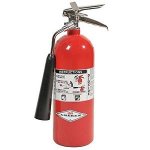Thanks for warning but you left me wondering what the problem is with my ABCs. This site had some useful info:
http://www.safety-marine.co.uk/spages/Engine-Fire-Extinguishers.htm .
When NOT to Use a Dry Powder Fire Extinguisher!
The most common type of fire extinguisher found on a boat is the dry powder model. This is a useful 'all-round' fire extinguisher suitable for the situations identified by fire classifications A, B and C. (For an explanation of these classifications, see
Fire Classifications & Fire Extinguishers.)
However, when you discharge a dry powder extinguisher it leaves a fine layer of powder, - much of which can turn into a sticky mess when it touches flames or hot metal.
The substance found in most dry powder fire extinguishers usually consists of either ammonium phosphate, potassium bicarbonate or sodium bicarbonate (otherwise known as bicarbonate of soda or baking powder!)
Unfortunately, ammonium phosphate can react with any moisture present to form phosphoric acid, which is highly corrosive and can easily seep into the smallest cracks in equipment, as well as remove paint. Left in place, the powder will draw moisture from the air and a common example of this acid corrosion will be chrome being replaced with rust.
More seriously, should the powder get taken into the air intakes, it could quite easily ruin the engine.
So even though you managed to tackle an engine fire quickly by discharging an extinguisher through the little hole in your engine bay cover, you may have caused more damage to your engine than the fire itself, simply because of your choice of fire extinguisher.
Fire industry professionals will always advise you to
avoid using a dry powder fire extinguisher in an engine space - but if you have no choice, then it is critical that you shut the engines down first.
I just checked both of mine and they have ammonium phosphate based dry chemical.....which you do not want. The only CO2 or halotron extinguishers I can find are $150 or so. Ouch!!







